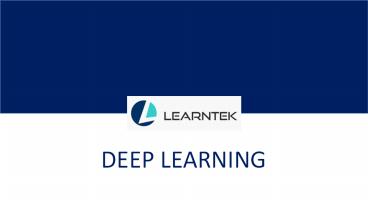Deep Learning Online Training - PowerPoint PPT Presentation
Title:
Deep Learning Online Training
Description:
Learntek is global online training provider on Big Data Analytics, Hadoop, Machine Learning, Deep Learning, IOT, AI, Cloud Technology, DEVOPS, Digital Marketing and other IT and Management courses. We are dedicated to designing, developing and implementing training programs for students, corporate employees and business professional. – PowerPoint PPT presentation
Number of Views:377
Learn more at:
http://www.learntek.org
Title: Deep Learning Online Training
1
- DEEP LEARNING
2
- The following topics will be covered in our
- Deep Learning
- Online Training
3
Deep Learning with TensorFlow
- Deep Learning is a subfield of machine learning
concerned with algorithms inspired by the
structure and function of the brain called
artificial neural networks. It is intersection of
statistics, artificial intelligence, and data to
build accurate models. TensorFlow is one of the
newest and most comprehensive libraries for
implementing deep learning. With deep learning
going mainstream, making sense of data and
getting accurate results using deep networks is
possible.
4
How it works
- A deep learning model is designed to continually
analyze data with a logic structure like how a
human would draw conclusions. To achieve this,
deep learning uses a layered structure of
algorithms called an artificial neural network
(ANN).
5
What you will learn from this course
- This course will offer you an opportunity to
explore various complex algorithms for deep
learning. You will also learn how to train model
to derive new features to make sense of deeper
layers of data. Using TensorFlow, you will learn
how to train model in supervise and unsupervised
category.
6
Introduction to Deep learning
- AI and Deep learning
- Advantage of Deep learning
- Deep Learning Primitives
- Deep Learning Architecture
- The Neural viewpoint
- The Representation Viewpoint
7
TensorFlow Fundamentals
Introduction of Tensors Installation of Tensors Scalars, Vectors, and Matrices Matrix Mathematics Initializing Constant Tensors Basic Computation using TensorFlow Sampling Random Tensors TensorFlow Variable Tensor Addition and Scaling Matrix Operation Tensor Shape Manipulation Tensor Types TensorFlow Graphs TensorFlow Sessions Logistic Regression Model Building and Training
8
Introduction to Neural Network
Basic Neural Network The Neurons Single Hidden Layer Model Multiple Hidden Layer Model Input, Output, Hidden Layers Details of Activation Functions Sigmoid Function Hyperbolic Tangent Function, SoftMax Selection of Right Activation Functions Network learning technique Weight initialization Forward Propagation Backpropagation Optimization Algorithms Regularization
9
Linear and Logistic Regression with TensorFlow
- Overview of Linear and Logistic Regression
- Loss Functions
- Gradient Descent
- Automatic Differentiation Systems
- Learning with TensorFlow
- Training Linear and Logistic Regression model
- Evaluating Model Accuracy
10
Convolutional Neural Networks
- Visual Cortex Architecture
- Convolutional Layer
- Filters
- Stacking Multiple Feature Maps
- TensorFlow Implementation
- Pooling/Subsampling
- Fully Connected Layer
- MNIST digit classification example
11
Recurrent Neural Networks
Recurrent Neurons Memory cells Input and Output Sequences Basic RNNs in TensorFlow Static Unrolling through Time Dynamic Unrolling through Time Handling Variable Length Input/output Sequence Training RNNs Creative RNNs Deep RNNs Distributing a Deep RNN Across Multiple GPUs The Difficulty of Training over many Time Steps
12
Reinforcement Learning
Policy Search Introduction to OpenAI Gym Neural Network Policies The Credit Assignment Problem Policy Gradients Markov Decision Process Temporal Difference Learning and Q-Learning Approximate Q-Learning and Deep Q-Learning
13
Prerequisites
- Basic understanding of linear algebra , calculus
and probability are must for really
understanding deep learning . It is expected that
one has some knowledge or experience in basic
Python programming skills with the capability to
work effectively with data structures .
Understanding how to frame a machine learning
problem, including how data is represented will
be an added advantage.
14
Who can attend
- Anyone who has coding experience with an
engineering background or relevant knowledge in
mathematics and computer science can take this
session to get understanding of Deep learning.
15
(No Transcript)































